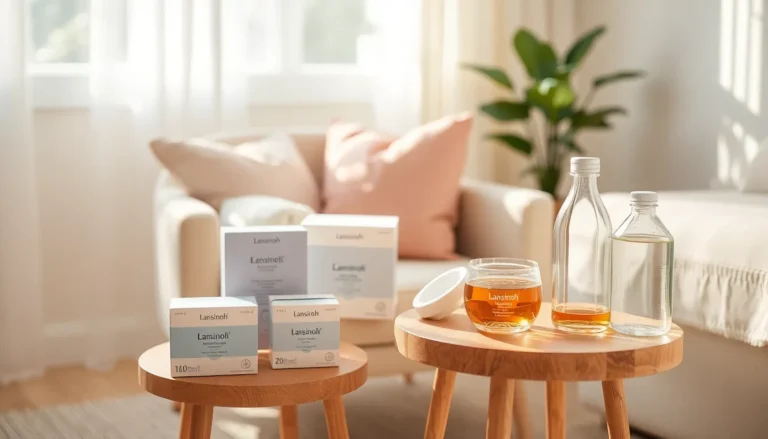After childbirth, many new parents find themselves navigating the uncharted waters of recovery. Among the many topics that might not make it to casual dinner conversations is perineal healing. Yes, that’s right—it’s time to shine a light on an area that deserves a little TLC and a lot of understanding.
Table of Contents
ToggleUnderstanding Perineal Healing
Perineal healing plays a crucial role in recovery after childbirth. Women often face physical challenges that require attention and care during this time.
Importance of Perineal Healing
Perineal healing contributes significantly to a woman’s overall well-being post-birth. Healing reduces discomfort and promotes mobility, impacting day-to-day activities and emotional health. Proper care can prevent complications, such as infections or chronic pain. Awareness of perineal health can facilitate better postpartum care and encourage open conversations about recovery.
Common Issues Encountered
Women often experience several issues during perineal healing. Pain at the site of tearing or episiotomy can cause discomfort during movement and sitting. Issues like swelling and bruising also contribute to prolonged recovery. Some may encounter infections if care isn’t adequate. Urinary incontinence and fecal incontinence are other significant concerns, often affecting women’s confidence and quality of life. Identifying and addressing these issues is essential for a smoother recovery process.
Methods of Perineal Healing
Effective approaches for perineal healing focus on both natural recovery processes and medical interventions. Understanding these methods enhances recovery for new mothers.
Natural Healing Processes
Natural healing occurs as the body works to restore tissue integrity. Blood flow increases to the perineal area, aiding in the healing of tears or incisions. Nutrient-rich foods play an essential role, as vitamins A, C, and E support skin repair. Gentle cleaning with warm water reduces irritation and promotes comfort. Adequate hydration prevents constipation, easing pressure on the perineum. Resting helps the body focus resources on healing, making it vital for new mothers. Engaging in pelvic floor exercises strengthens muscles, which can alleviate discomfort and promote recovery.
Medical Interventions
Medical interventions provide additional support for perineal healing when necessary. Pain relief options, such as topical anesthetics or prescribed medications, help manage discomfort effectively. If swelling or bruising occurs, ice packs can reduce inflammation and promote blood circulation. Some may benefit from physical therapy targeting the pelvic floor, enhancing muscle recovery and function. For severe tears, follow-up appointments with a healthcare provider ensure proper healing and monitor potential complications. Urinary or fecal incontinence symptoms warrant evaluation and may involve specialized treatments or exercises. Overall, medical guidance enhances recovery and addresses specific needs.
Strategies for Promoting Perineal Healing
Promoting perineal healing involves specific practices that support recovery after childbirth. Implementing effective strategies can significantly enhance comfort and well-being.
Hygiene Practices
Maintaining proper hygiene is essential for healing the perineum. Gentle cleansing with lukewarm water helps remove bacteria without causing irritation. Women should avoid harsh soaps and perfumed products, as these can lead to discomfort. Soft cotton pads or breathable underwear provide additional comfort and reduce friction on sensitive areas. Frequent changing of sanitary pads prevents moisture buildup, which can minimize the risk of infection. Always pat the area dry rather than rubbing, ensuring that it remains clean and dry. Regular handwashing before and after wiping is crucial for reducing the chances of introducing harmful bacteria.
Use of Topical Treatments
Topical treatments can significantly aid perineal healing. Applying aloe vera gel offers soothing properties that reduce inflammation and promote tissue regeneration. Witch hazel pads may provide cooling relief and alleviate discomfort. Oxygen-rich ointments help in speeding up the healing process and can be applied to stitches if necessary. Using pain-relief sprays designed for postpartum care can also ease discomfort associated with healing. It’s important to consult with a healthcare provider before starting new topical treatments to ensure safety and effectiveness during recovery. Combining these treatments with supportive practices promotes a smoother healing experience.
Research on Perineal Healing
Perineal healing is an area garnering increased attention in medical research, focusing on recovery processes post-childbirth. Recent studies have highlighted the significance of targeted care during this critical period.
Recent Studies and Findings
Recent findings emphasize the impact of perineal care practices on healing outcomes. A study published in the “Journal of Midwifery & Women’s Health” found that women who engaged in regular perineal hygiene experienced reduced rates of infection and shorter healing times. Another investigation revealed that pelvic floor exercises, when initiated early, improved recovery and minimized pain associated with tears or episiotomies. Furthermore, a 2022 systematic review noted that topical treatments using natural ingredients expedited tissue healing and alleviated discomfort for women postpartum. This body of research underscores the need for improved education on practical healing strategies.
Future Directions in Research
Future research will focus on exploring innovative therapies for enhancing perineal healing. Investigating the efficacy of different topical agents and their role in promoting faster recovery is essential. Examining various postpartum care models may provide deeper insights into effective support systems for new mothers. Additionally, the role of individualized care plans tailored to specific healing needs holds great potential for improving outcomes. Collaboration among healthcare professionals will foster a broader understanding of effective practices, bridging gaps in current knowledge and enhancing the overall recovery experience for women after childbirth.
Conclusion
Perineal healing is a vital component of postpartum recovery that deserves more attention. By fostering awareness and open dialogue, new mothers can better navigate the challenges they face during this period. Emphasizing proper care and hygiene practices not only enhances comfort but also supports overall well-being.
With a combination of natural methods and medical interventions, women can effectively manage their recovery journey. As research continues to evolve, the hope is that more tailored approaches will emerge, ensuring that every new mother receives the support she needs for a smoother healing process. Prioritizing perineal health is essential for empowering women during their transition into motherhood.



